During the course of our survey dives we see many representatives of the Phylum Mollusca (mollusks). Frequently we see gastropod (snail) shells but most are carried about the reef by small hermit crabs which have taken up residence in the shells after the snails have died. More commonly we see bivalves in the form of giant clams—which always beckon for a photo with their brightly colored and ornately patterned mantles—or nudibranchs, the “butterflies” of the reef, seemingly infinite in their colors and forms. Nudibranchs, like garden slugs, have done away with their external shell (lost during their larval stage). They protect themselves instead with toxic compounds that taste foul. Another group of mollusks that have shed their shells to increase their mobility are the members of the Class Cephalopoda.
The name cephalopod comes from the Greek for “head-foot” which adequately describes their body plan with a prominent head and a set of muscular appendages attached. Within the Class Cephalopoda there are three orders from which we have seen representatives during this mission: octopuses, squids and cuttlefishes.
Octopuses (Order Octopoda)—as hinted at by their name—are well known to have eight arms, each lined with suction discs. They use these arms and suckers to move about on the bottom where they live feeding upon fishes, crustaceans and other mollusks. In fact, the entrance to an octopus’ lair is often easily located by looking for the shells littering its entrance. When hunting they probe around on the bottom using each arm to feel into crevices looking for their prey. One common hunting technique that is fascinating to watch I call ‘tenting’ where they spread the mantle web between their arms over a patch of reef and begin groping around underneath with their arms hoping to scare-up a meal. When a prey item is trapped within the webbing and drawn to the mouth by the arms, the two-part beak takes bites out of it while salivary glands eject toxic digestive juices.
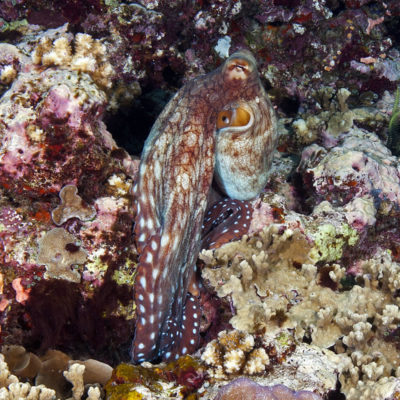
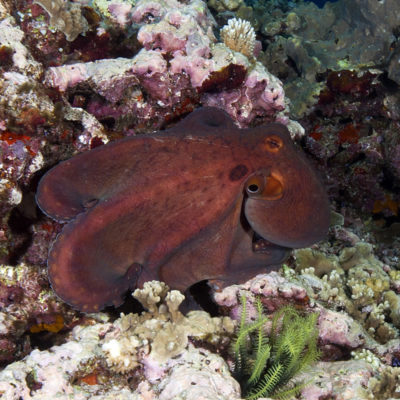
Two images of the same Day Octopus (Octopus cyanea) seconds apart demonstrate the remarkable color and texture control allowing it to quickly camouflage or express its mood.
(Click-thru on images for greater detail.)
Squids (Order Teuthida) have the eight sucker lined arms as do octopuses but they also have two longer arms termed feeding tentacles. These tentacles can elongate very rapidly (in just a matter of milliseconds) extending their reach by up to 70%. Watching a squid feeding always reminds me of nature specials showing chameleons catching insects with their extensible tongues. Although most cephalopods have an ink sac, squids are particularly well known for their ability to expel dark ink in order to confuse or distract predators. The ink (almost pure melanin) is usually mixed with mucus forming a cloud that, like a smokescreen, may hide the squid’s retreat. In some cases the ink cloud is so thick with mucus that it holds together and may act as a decoy while the squid escapes. Squids use jet propulsion for locomotion more than do octopuses. Water is drawn into the mantle cavity and through muscular contractions is forced out through the siphon, propelling the animal along. They supplement this with flapping the elongated fins that run the length of their mantle. With their large eyes, watching squids while they watch you is an enjoyable way of spending time during a safety stop at the end of a dive.
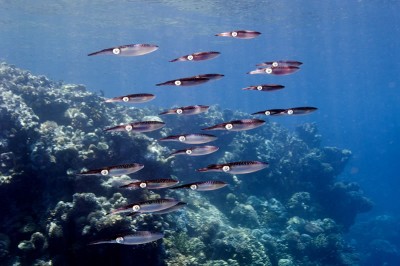
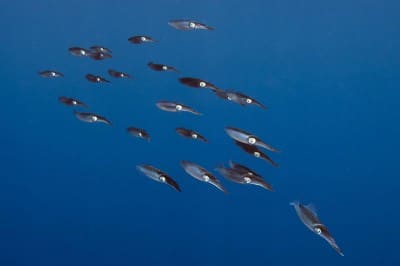
A squadron of Bigfin Reef Squid (Sepioteuthis lessoniana) sometimes encountered on the reef but more commonly seen in open water at the end of a dive.
(Click-thru on images for greater detail.)
Cuttlefishes (Order Sepiida) are built more similar to squids than to octopuses having eight arms and two feeding tentacles and a more flattened body rimmed with a thin muscular swimming fin. They are generally found lower in the water column than squids and are usually seen hovering just over the bottom. Cuttlefishes can be distinguished from squids by their stockier, broad bodies and their distinctively W-shaped pupils. A much reduced internal “shell” called a cuttlebone is used for buoyancy.
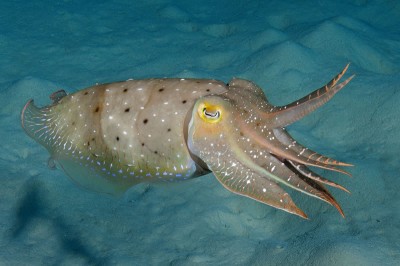
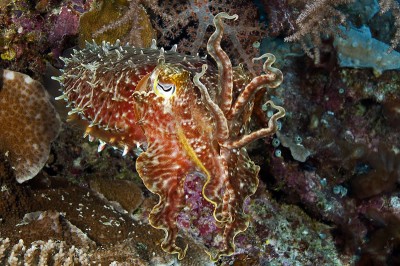
Broadclub Cuttlefish (Sepia latimanus) showing its capacity for color and texture variation as well as its interesting defensive posture with tentacles raised.
(Click-thru on images for greater detail.)
Cephalopods, with their ability to swiftly and dramatically alter their coloration through the use of specialized cells within the skin called chromatophores, are both masters of camouflage and yet can put on quite a display—indicating changes in mood with mercurial fluidity. These charismatic members at the apex of the mollusk phylum are always a joy to see on a dive and usually result in us taking a short break from our survey work to marvel for a moment at these most intelligent of invertebrates.
Photos by Ken Marks.
